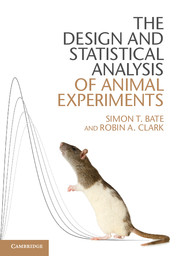5 - Statistical analysis
Published online by Cambridge University Press: 05 March 2014
Summary
Introduction
For the remainder of this text we shall consider the statistical analysis of (hopefully) well-designed animal experiments. If a suitable experimental design has been employed then the statistical analysis should be relatively straightforward. It should be as concise as possible while making best use of all available information. We argue that to achieve this, the experimental design should direct the statistical analysis.
By this stage of the experimental process the researcher should have:
identified all effects that may increase the variability of the data and attempted to account for them in the experimental design;
selected a suitable sample size;
measured a response that contains as much information as possible;
attempted to ensure that other nuisance effects have not biased the experimental results.
With these criteria satisfied the analysis should be straightforward and hopefully give reliable and meaningful conclusions.
Before we describe in more detail some of the analyses available when analysing data generated from animal experiments, there are a number of general issues worth considering.
Use the experimental design to direct the analysis
As stated above, in animal experiments we have the luxury of having almost complete control over the experimental design. We should make the most of this in the statistical analysis. As we have seen in the previous chapter, dii cult decisions regarding the analysis strategy can be solved, or at least a justifiable solution found, by recourse to the experimental design and randomization (for example, see Section 4.2.3 for decisions on repeated measures status and Section 4.2.2 for model selection).
- Type
- Chapter
- Information
- The Design and Statistical Analysis of Animal Experiments , pp. 132 - 237Publisher: Cambridge University PressPrint publication year: 2014

